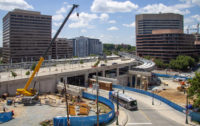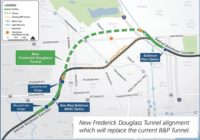A contentious special session of the Hawaii Legislature has averted the latest crisis for Honolulu’s controversial light-rail project, enacting a $2.4-billion financial bridge that backers hope will carry construction of the planned 20-mile, $8-billion system to completion in 2025. Already six years behind schedule, the state’s largest public-works effort still faces an uncertain future.
The funding, approved on Sept. 1, is intended to help salvage a $1.55-billion Federal Transit Administration grant approved in 2012, when work began on the elevated guideway, steel-wheel-on-steel-rail system, originally budgeted at $5.26 billion. At the time, opponents’ lawsuits already had delayed the construction start by three years, says Honolulu Authority for Rapid Transportation (HART) spokesman Bill Brennan. “That pushed work and bidding on new contracts into a more expensive time for us,” he says, noting that rebar and concrete costs exceeded recession-era estimates in the $483-million design-build contract for the first 10.5 miles of guideway and track, awarded in 2009 to what is now Kiewit Infrastructure West Co. Construction is inherently expensive in Honolulu, due to lengthy approvals, high land costs and materials imported by sea, says General Contractors Association of Hawaii President Cedric Ota. A recent building boom further increased costs and strained skilled-labor availability.
Brennan says station design changes added to the cost, as did a decision to relocate electrical utilities underground around the guideway structures to avoid clearance issues. That move added an estimated $200 million. HART’s leadership came under fire for its handling of quality issues and change orders on concrete guideway structures designed by FIGG Bridge Enterprises and HNTB. An agency award submission says the guideway was designed to be built from above using precast-concrete superstructure elements to accommodate “the congested urban location.” Kiewit and HNTB declined to comment, referring inquiries to HART. FIGG did not respond.
A year-long city audit in April 2016 identified deficiencies in HART’s financial, project-management and contract controls. The audit said, “Project cost details, methodologies, and cost assumptions are unsubstantiated.” The findings led to the August 2016 resignation of executive director Dan Grabauskas, who recently was succeeded by former Bombardier senior executive Andrew Robbins (ENR 8/7-8/14/17 p. 19). Amid the turmoil, HART has pushed other parts of the project. Last year, it awarded design-bid-build contracts for the first nine stations to two Honolulu contractors.
In December 2016, the joint venture of Shimmick, Traylor and Granite began work on a $875-million design-build contract for the next five miles of guideway that will include a link to Honolulu International Airport and four stations. Joint-venture project manager William Corn says the overall team has been efficient in completing design for early elements, such as deep foundations and columns. Both are set to start construction this fall, “months ahead of schedule,” he says. But those awards, plus a $1.4-billion contract for core systems operations and rolling stock, nearly have exhausted HART’s budget, jeopardizing both the final 4.3-mile, eight-station segment into downtown Honolulu and the remaining half of the FTA grant. After a week of heated debate, legislators approved extensions of local taxes to the end of 2030, plus a new state audit and annual financial reviews.
Brennan says that, while there is no timetable for FTA to issue a decision, he expects communication “over the next several months.” Meanwhile, HART is evaluating alternative delivery methods for the final segment, including private-sector finance and operations involvement.





